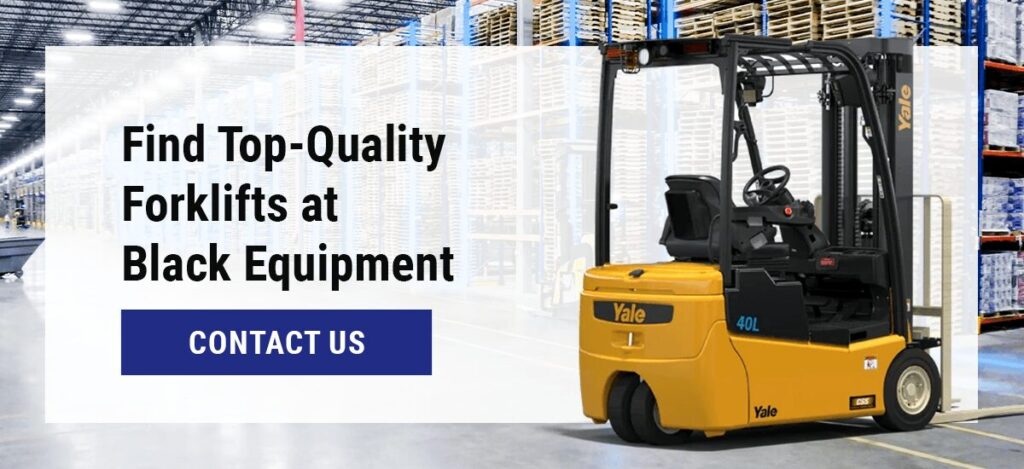8 Forklift Operator Safety Features You Need to Know
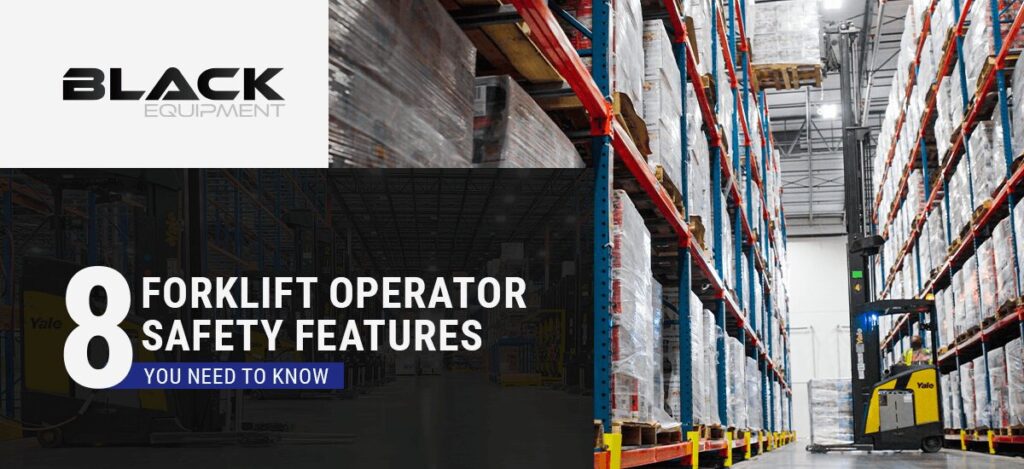
Safety is a critical consideration in material handling. From slips, trips and falls to pedestrians being mousetrapped between a forklift and an object, facilities must carefully plan how to address each hazard to protect employees and property. Purchasing equipment with built-in safety features reduces risk without requiring companies to invest in additional gear after the initial purchase.
These eight forklift operator features are essential for keeping personnel safe while on the floor, which can improve worker retention and keep businesses in compliance with key Occupational Safety and Health Administration (OSHA) requirements.
1. Seat Belts
Forklifts with built-in seat belts reduce the risk of serious injury and adhere to requirements from the American Society of Mechanical Engineers (ASME) and OSHA.
Forklift seat belts can also integrate with other safety features like a dynamic stability system (DSS) or rollover protection structure (ROPS), further lowering the operator’s risk with automated adjustments and active corrections of risky driving behaviors.
Operators must also ensure the seat is clean and free of clutter to ensure proper seat belt fastening. Proper posture, careful driving and a strong safety culture can help increase the likelihood that operators wear their seatbelts as needed.
2. Ergonomic Features
Although there are no specific OSHA requirements regarding ergonomics, employers are expected to provide a comfortable and safe work environment for their employees. Ergonomic design elements are essential for achieving that goal and reducing the risk of musculoskeletal disorders (MSDs).
Ergonomic features, including the following, help operators feel more comfortable on the job and protect their bodies from injury, which raises morale and motivates workers to stay on task longer:
- Adjustable seats that reduce fatigue and increase operator comfort by accommodating the operator’s individual form.
- Full-suspension seats that protect the operator’s spine by absorbing vibration and impact.
- Armrests to support the arms and shoulders, reduce strain on the upper body and promote good posture.
- Easy-to-use controls that reduce mental and physical strain.
- Enhanced frontal visibility through the mast via technologies like fork-mounted cameras.
- Noise-reducing cabins to protect operators’ hearing in loud working environments.
For example, Hyster’s Ultra Cushion Platform uses military-grade construction to reduce shock and vibration by as much as 30% when compared to conventional rubber mats. This capability enables the platform to enhance operator comfort and provide steady footing during operation.
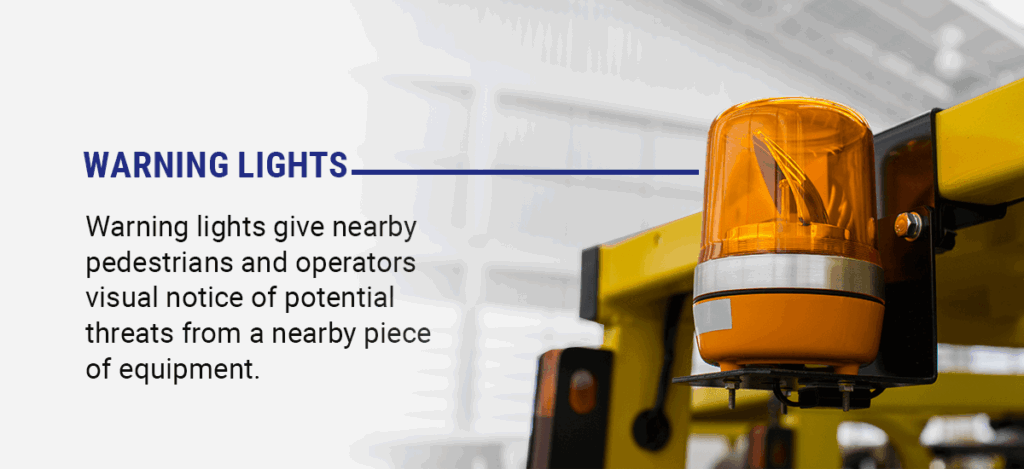
3. Warning Lights
Warning lights give nearby pedestrians and operators visual notice of potential threats from a nearby piece of equipment. Common types of forklift warning lights include:
- Headlights: Headlights help make the truck more visible to employees and other operators in the vicinity. They also help operators see their working environment more clearly.
- Brake lights: A set of brake lights alerts other employees and truck operators to stop or slow down, reducing the risk of collisions.
- Flashing warning lights: Strobe lights help alert pedestrians of the forklift’s presence in areas where ambient noise can drown out backup alarms. They’re often available in different lens colors so fleet managers can choose the most visible option for their facilities.
- Directional lights: These lights project an arrow onto the ground in front of the forklift to indicate its path of travel and warn employees working nearby.
- Red zone lights: These vertical lights project red beams onto the floor to create a visual barrier around the lift so pedestrians know to keep their distance.
- Blue safety lights: Blue LEDs project a blue spot onto the floor in front of them, alerting employees to the truck’s presence when turning around corners and in congested spaces.
Combining lights and alarms can help by accounting for employees who may be hard of hearing or who may be working in areas of poor visibility. If the employee notices at least one of the alerts that a lift truck is coming, they have some measure of advance notice to safely get out of the way.
4. Active Operator Assist Systems
Active operator assist systems help operators stay aware of their surroundings with features such as:
- Object detection and avoidance: A system of LIDAR and proximity sensors detect objects, pedestrians or obstacles in the truck’s path, automatically adjusting speed or stopping the forklift to prevent collisions.
- Dynamic speed control: The forklift adjusts travel speed in real time based on load height, load weight, proximity to objects or predefined zone rules, ensuring safe operation under varying conditions.
- Zone-based performance limits: The system enforces customizable speed and acceleration limits within predefined warehouse zones, such as pedestrian areas or tight aisles. This feature is configurable via Yale Vision telemetry.
- Load stability management: This feature monitors load height and weight, modulating hydraulic functions such as lift and tilt speed to maintain stability and prevent tip-overs or load drops.
- Operator-specific settings: These settings integrate with Yale Vision to apply tailored performance adjustments based on operator login, which aligns safety controls with individual skill levels.
- Audible and visual alerts: If the truck detects a hazard, such as nearby pedestrians or excessive driving speed, the system provides real-time warnings to the operator to reinforce safe behavior.
- Automatic braking: When critical hazards, such as an imminent collision, are detected, the forklift automatically engages the brakes to stop the truck. This feature helps reduce reliance on operator reaction time to avoid more accidents.
In addition to reducing the risk of accidents, active operator assist systems can enhance precision, efficiency and productivity in your warehouse or distribution center.
5. Remote Monitoring Systems
Connected telemetry systems like Hyster Tracker and Yale Vision help fleet managers optimize maintenance schedules and catch issues before they can lead to dangerous breakdowns and malfunctions. This capability is called predictive maintenance.
It improves on the proactive principles of preventive maintenance by incorporating internet-connected sensors that continuously monitor equipment condition and alert operators and managers when a repair is needed — even if the next maintenance check isn’t for another few months.
Telemetry systems are helpful for fleet management because they can help managers and employees identify potential issues early, which reduces maintenance costs and helps keep employees safe from preventable workplace accidents.
A knowledgeable sales rep can walk you through the operation of these systems and demonstrate how they might work in your facility, which is essential for making an informed decision.
6. Dynamic Stability System (DSS)
The Dynamic Stability System (DSS) actively monitors a lift’s operations and makes adjustments in real time to correct potential instabilities. These automatic changes enhance operator safety and increase efficiency by reducing the risk of stability-related accidents such as tip-overs.
Here’s a brief explanation of how DSS works in Yale and Hyster DSS-equipped lift trucks:
- Lateral stability system: DSS uses its unique steer axle design to reduce truck lean and improve navigation on uneven surfaces.
- High-lift traction control: Corner control and high-lift traction control limit speed based on steering angle and elevated loads. These are straightforward, sensor-based adjustments.
- High-lift tilt control: DSS limits how far and how fast operators can tilt the truck’s forks when they are raised. High-lift tilt control limits tilt speed and forward tilt range when the load exceeds a height threshold. This is a sensor-driven hydraulic restriction based solely on height and load rather than external conditions.
- Corner control: The system ensures forklifts safely round corners by dynamically limiting the truck’s speed when navigating corners, reducing the risk of lateral tip-overs or loss of stability during turns. DSS alerts the operator with audio alarms and visual alerts, which are displayed on the truck’s operator dashboard screen.
DSS is maintenance-free and is built into the Hyster A Series and Yale N Series forklifts, making it a convenient option for facilities looking to invest in emerging technologies. It’s also highly adaptable to any facility, which enables operators in warehousing, distribution centers and 3PLs to optimize the system to meet unique requirements.
For more information on this system, facilities should connect with an experienced professional.
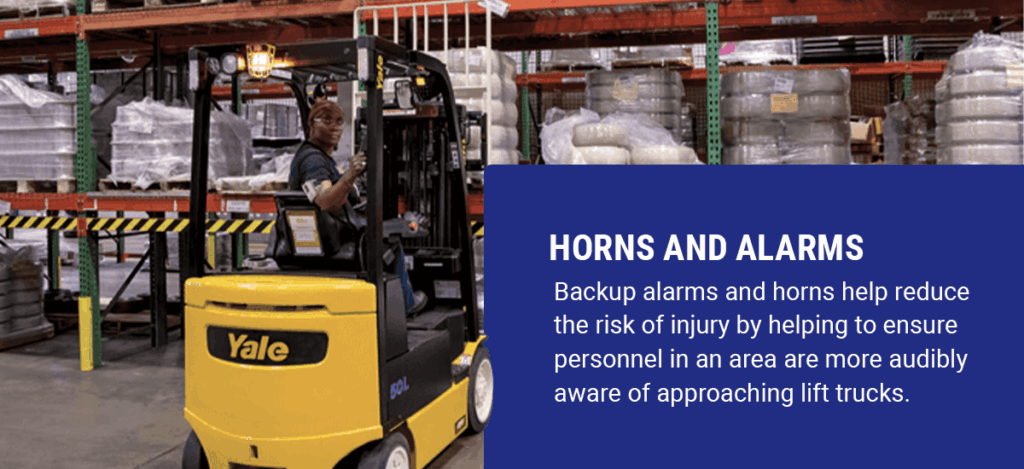
7. Horns and Alarms
Forklifts equipped with backup alarms and horns help reduce the risk of injury by helping to ensure personnel in an area are more audibly aware of approaching lift trucks. This feature is especially critical when operators need to back out of tight areas, as rear visibility is often limited.
A forklift can have any of the following alarm types:
- Backup: An alarm sounds when the forklift is reversing.
- Motion: Moving forward or backward activates a motion alarm.
- Continuous motion: With key-on, this type of alarm system activates the alarm continuously.
Forklift operators are also trained to use their horns and slow down when approaching blind corners and intersections.
8. Overhead Guards
When combined with the proper personal protective equipment (PPE), overhead guards protect operators’ heads from falling objects. OSHA Standard 1917.43(e)(1) requires all industrial lift trucks to be equipped with secure overheard guards that do not interfere with operator visibility.
These protective structures are located on top of the forklift’s cabin and form a grid over the operator’s head to deflect incoming hazards. They can be either fixed or retractable, depending on the operator’s specific environment and storage requirements.
As with any other forklift component, regular inspection and maintenance are critical for ensuring lasting protection and operation.
How to Choose a Forklift With the Safety Features You Need
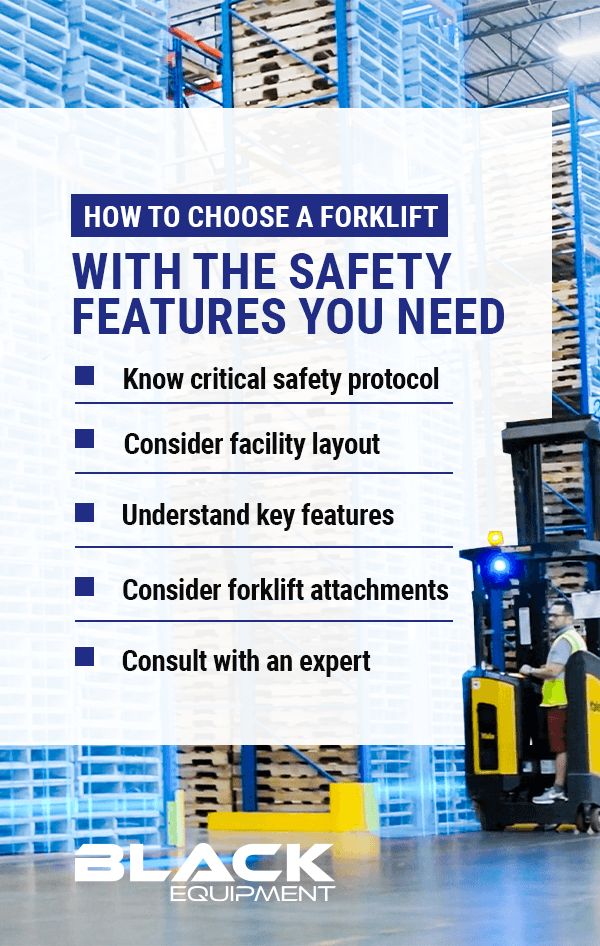
While determining which safety features are most relevant for your operation is easy, choosing a model that has all the features you want can be more challenging. The following considerations can help material handling facilities assess which forklift models are most suitable for their applications:
- Know critical safety protocols: Fleet managers and operators should have a strong understanding of the OSHA and ASME requirements that apply to their specific operations because this information can provide insight into which features best fit their needs.
- Consider facility layout: The organizational scheme and unique layout of a warehouse or distribution center directly impact the size and type of forklift a facility should buy. For example, a facility with narrow aisles should consider lift trucks optimized for vertical storage.
- Understand key features: In addition to operator safety features, facilities should consider critical factors like mast height restriction, load capacity and motive power type to ensure the lift is optimized for their unique operation.
- Consider forklift attachments: Attachments expand a forklift’s functionality by enabling it to perform tasks outside of its original scope, which can benefit facilities with highly specific needs.
- Consult with an expert: Consulting a professional is highly advisable. A knowledgeable sales representative with experience in your industry can help you identify models that best meet your specific needs and application.
Black Equipment provides customized solutions for material handling applications across various industries, including manufacturing, construction, warehousing and more. Our team has extensive experience in working with industry-leading forklift models and emerging technology, so we can provide valuable advice for facilities looking to find the right lift truck for their application.
Frequently Asked Questions About Forklift Safety
Here are some of the most frequently asked questions facilities have regarding forklift safety features and best practices.
What Kind of Training Do Forklift Operators Need?
According to OSHA Regulation 1910.178(l), all lift truck operators must take an operator training course with a certified instructor. Upon successful completion of this course, which often includes both a classroom phase and a hands-on phase, operators are licensed to use forklifts in operational settings. Black Equipment offers both Operator Training and Train-the-Trainer courses, giving organizations the option to conduct ongoing training in-house.
How Can You Ensure Employees Use Forklift Safety Features?
Developing a strong safety culture across your organization is the best way to ensure employees use forklift safety features as intended. A safety culture encompasses an organization’s entire value system, including encouraged actions and behaviors relating to safety.
In companies with robust safety cultures, employees hold each other accountable for following necessary measures such as wearing seat belts and activating operator assist systems before beginning work.
How Can You Keep Forklifts in Good Condition?
Preventive maintenance is essential for keeping forklift safety features in good operating condition. Forklifts equipped with telemetry systems can also allow operators to switch to a predictive maintenance strategy, which enables them to augment lift truck repairs if circumstances indicate it’s necessary.
How Does Safety Improve Operator Retention?
Forklifts equipped with advanced safety features improve operator retention by making team members feel confident and comfortable at work, which encourages them to work more efficiently.
Ergonomic features are especially important for helping forklift operators stay physically healthy, as poor posture and lifting skills can cause the development of lasting musculoskeletal disorders and impact employees’ quality of life. Adjustable seats, supportive operator platforms and easy-to-use controls can all help operators stay comfortable while on the job, even during long shifts.
How Can Fleet Managers Minimize Risk When Choosing New Forklifts?
Procurement and fleet managers should have a strong understanding of what types of hazards are present in their facilities to minimize risks when choosing new forklifts. This information can help them plan which features to look for in a new model and determine a strategy for assessing potential threats they may not currently be aware of.
Find Top-Quality Forklifts at Black Equipment
While straightforward safety protocols are essential for compliance with OSHA and ASME regulations, your team needs tools that make meeting those standards easier. The expert staff at Black Equipment can help your business find the best equipment for your situation.
We specialize in material handling equipment and attachments from industry-leading brands like Yale and Hyster, and our team has extensive experience with their equipment offerings. Black Equipment is your go-to source for everything from planning and specifying to delivery, training, parts, maintenance and repairs.
Contact us today for more information about any of our equipment.
